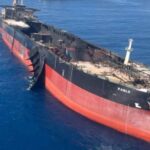Energy News Beat
With the numbers of the so-called shadow tanker fleet peaking 10 months ago, there’s now evidence that many of the oldest vessels are being primed for scrap, though getting a good demo price for these sanctions-busting ships is proving hard.
The 25-year-old Bradley aframax is now headed on its final voyage to Pakistan to meet the breaker’s torch. The ship was first mooted for demolition last October when sold to a cash buyer for $500 per ldt, a deal that failed when it was accused of hauling Russian crude. The ship then remained anchored in the South China Sea with brokers BRS reporting recently it has now been sold for scrap at a cut price of $450 per ldt.
Shadow tankers will face challenges in the secondhand and demolition markets
“Any tanker accused of partaking in shadow fleet business will face challenges in the secondhand and demolition markets,” BRS noted in a recent tanker report.
Pareto Securities, meanwhile, has reported that the 2005-built Adisa VLCC has been sold for demolition, a ship sanctioned by the US for its involvement in Iranian and Venezuelan tanker trades.
A more infamous name in the dark fleet is also being dismantled in Southeast Asia. One of last year’s most high-profile tanker casualties has been towed to Indonesia where it is being scrapped.
The Pablo aframax exploded on May 1 in Malaysian waters, killing three crewmembers. The charred remains of the 1997-built ship was one of the shipping images of 2023, a stark reminder of the risks associated with the dark tanker fleet. Since 2018, TankerTrackers.com evidenced this vintage ship transfer 16m barrels of Iranian oil on 29 occasions.
The Group of 7 Nations and Australia, known as the price cap coalition, agreed in 2022 to cap Russia’s oil export prices at $60 per barrel. In December, the price cap coalition also tightened compliance rules for insurance firms and shippers. This move will require service providers, including shippers and movers of Russian oil, to receive attestations from their purchasers and sellers each time they lift or load Russian oil. It will also require insurance and freight firms to share these documents upon request with entities further down the supply chain.
“Whether Russia can continue to maintain its shadow fleet remains to be seen but it is not becoming easier,” pointed out a recent report from Arctic Securities, which also noted that the US is tightening compliance on Iran and Venezuela.
Craig Kennedy, who authors the well-researched Navigating Russia substack, detailed last month how Moscow’s shadow fleet has been running into sanction headwinds.
The recent campaign by price cap coalition countries to step up pressure on intermediaries in the shadow oil trade appears to be having an effect, Kennedy argued.
“The campaign has included a series of public enforcement actions against a small sampling of market players—shipowners, ship brokers and oil traders. It has also, reportedly, involved private overtures to a range of other entities—foreign banks, flag registries, insurers and the like—urging them to show greater diligence in their price-cap compliance,” Kennedy wrote.
Analysts at Vortexa issued a recent report showing that tankers operating in opaque markets reached a record high in Q2 last year and have since declined.
The latest data from BRS suggests there are a total of 675 tankers in what it terms as the grey fleet, representing 7.4% of the total global tanker fleet.
The peaking of the shadow fleet is also reflected in the sale and purchase market in recent days with Splash reporting earlier this week that prices for vintage VLCCs are coming down.
The post Shadow fleet faces tricky path to the breaker’s torch appeared first on Energy News Beat.








